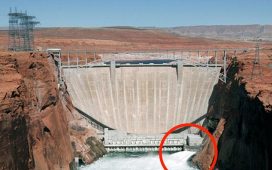A mass dying around 2.05 billion years ago wiped out more than 80 per cent of life and dwarves all mass extinctions — including the one that killed the dinosaurs.
Unlike the large animals that went extinct in these other events, however, the newly-recognised die-off involved tiny, simple microorganisms.
Researchers found evidence of the dying in rocks from Canada, whose isotope ratios preserve information of the environment at the time they were formed.
The die-off following a boost in the Earth’s atmospheric and oceanic oxygen levels which had been accompanied by an increase in the abundance of life.
As the microorganisms of the time used up their nutrients, however, their numbers were forced to fall back down again.
Scroll down for video

A mass dying around 2.05 billion years ago wiped out more than 80 per cent of life — eclipsing all mass extinctions including the one that killed off the dinosaurs. Pictured, barite-bearing rocks from Canada’s Belcher Islands that date back to around 2 billion years ago
Geologists Malcolm Hodgskiss of California’s Stanford University, Peter Crockford of the Weizmann Institute of Science, Israel and colleagues studied rocks collected from the Belcher Islands, on the southeastern side of Canada’s Hudson Bay.
In particular, the team focused on a sulfate mineral called barite, which can store a record of the levels of oxygen found in the atmosphere and the extent of life’s productivity at the time it was formed.
Studying oxygen, sulphur and barium isotopes in the rock samples, the researchers found that the Earth’s biosphere — the regions of the planet occupied by life — underwent vast changes beginning around 2.4 billion years ago.
This was the time of the so-called Great Oxidation Event, when a vast amount of free oxygen was released into the atmosphere for the first time and ancient microbial life multiplied — but it had been unclear how this event ended.
The researchers found that there was an enormous decrease in the number of living organisms around 2.05 billion years ago — one which may be linked to the decline in oxygen levels.
More than 80 per cent of life may have died off at this time, the team believe — making this extinction greater than both the event that killed off the dinosaurs around 66 million years ago and the so-called ‘Great Dying’ 252 million years ago.
‘The fact that this geochemical signature was preserved was very surprising,’ said Mr Hodgskiss.
‘What was especially unusual about these barites is that they clearly had a complex history.’
The findings offer a rare window into life around two billion years ago, during a period before complex life from which the fossil record is extremely sparse.
‘This shows that even when biology on Earth is comprised entirely of microbes, you can still have what could be considered an enormous die-off event that otherwise is not recorded in the fossil record,’ said Mr Hodgskiss.
The finding of an association between the proliferation of life and the ancient Earth’s atmospheric oxygen levels supports a hypothesis concerning the Great Oxygenation event that is dubbed the ‘oxygen overshoot’.
This suggests that the weathering of rocks and energy production by ancient microorganisms release a colossal amount of oxygen into the Earth’s atmosphere.
However, these levels are believed to have later fallen off as the oxygen-emitting organism in the oceans exhausted their nutrient supplies and decreased in number.
This situation is unlike the stable atmosphere found on the Earth today, where the amount of oxygen created and that consumed essentially balance each other out.

Studying oxygen, sulphur and barium isotopes in the rock samples, pictured, the researchers found that the Earth’s biosphere — the regions of the planet occupied by life — underwent vast changes beginning around 2.4 billion years ago
The researchers’ isotope data will help to refine estimates of the size of the oxygen overshoot by revealing the impact it had on life.
‘Some of these oxygen estimates likely require too many microorganisms living in the ocean in Earth’s past,’ said Dr Crockford.
‘So we can now start to narrow in on what the composition of the atmosphere could have been through this biological angle.’
‘The size of the biosphere through geologic time has always been one of our biggest questions in studying the history of the Earth,’ said Stanford university geologist Erik Sperling, who was not involved in the present study.
‘This new proxy demonstrates how interlinked the biosphere and levels of oxygen and carbon dioxide in the atmosphere are.’
The full findings of the study were published in the journal Proceedings of the National Academy of Sciences.

Geologists Malcolm Hodgskiss of California’s Stanford University, Peter Crockford of the Weizmann Institute of Science, Israel and colleagues studied rocks collected from the Belcher Islands, on the southeastern side of Canada’s Hudson Bay














